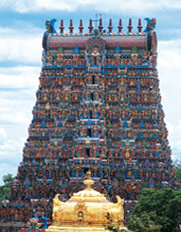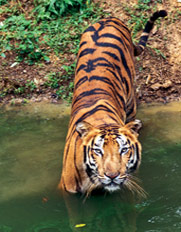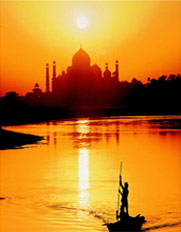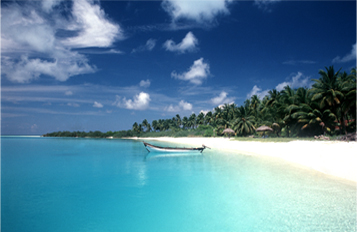 |
 |
 |
 |
Ooty
Ooty , is a city, and the district capital of the Nilgiris district in the South Indian state of Tamil Nadu.
Ootacamund is a popular hill station located in the Nilgiri Hills. The origin of the name Ootacamund is obscure, but "mund" is the Badaga word for a Toda village, and it is probably a corruption of the Badaga name for the central region of the Nilgiri Plateau. Another likely origin of the stem of the name ("Ootaca") comes from the local language Tamil where "Otta-Cal" literally means "Single Stone". This is perhaps a reference to a sacred stone revered by the local Toda people. Udhagamandalam is a more recent official Tamil name for the town. Ooty stands at an approximate height of 7,440 feet (2,268 m) above sea level.
History
Front of Ootacamund Club, 1905.The Nilgiri Hills were part of Chera Empire in ancient times. Later it fell into the hand of ganga dynasty, and then Hoysala empire under king Vishnuvardhana in the 12th century. They then became part of the Kingdom of Mysore of Tipu Sultan who later surrendered them to the British in the 18th century.
John Sullivan, the British governor of neighbouring Coimbatore province, liked the climate of this forested land, and occupied it by taking land from the native tribes (Toda, Irumba and Badaga); often buying up many square kilometres in a day for the price of a few meals.
The hills were developed rapidly under the British Raj because they were almost entirely owned by private British citizens, unlike the rest of India. Ooty served as the summer capital of the Madras Presidency, and had winding hill roads and a complicated rack railway system built by influential and enterprising British citizens with venture capital from the Madras government.
Tourism
A panaromic view of OotyLocated in the mountainous range called the Blue Mountains or Nilgiris, Ooty draws a large number of tourists every year. The weather is quite pleasant at a mean of 15 to 20 °C (59 to 68 °F) year round, dropping to lows of 0 °C (32 °F) during winter. The hill town suffers from rampant commercialization and various other ecological and infrastructural issues.
The landscape is marked by rolling hills and plateaus covered with dense vegetation, tea gardens, and eucalyptus trees. Many portions of the hills are preserved as natural reserve forests, and special permits are needed to camp outside of campgrounds. Ooty is more of a focal point of attraction for tourists, who also undertake auto tours of the surrounding countryside.
The hilly region also houses smaller towns like Coonoor and Kotagiri. These towns are less than an hour's drive away from Ooty and enjoy the same climate, but have fewer tourists and cheaper prices.
Historical sites
Ooty Botanical Gardens
The 22 Acre Botanical Garden was laid out in 1847 and is presently maintained by the government of Tamil Nadu. The original purpose of the "Botanical Gardens" was purely academic: to promote and study the various flora in and around Nilgiris. Now, it is open to the public as a park that can be enjoyed by visitors. The Botanical Garden is also a heaven for bird watchers where a variety of birds, both seasonal and year-round residents, can be sighted. A flower show along with an exhibition of rare plant species is held every year in the month of May at this garden. The garden also has a 20 million year old fossilized tree.
Stone House
This was the first "Pukka" house in Ooty, built by John Sullivan. It is situated inside the premises of the Government Arts .
Toda Huts
There are a few number of Toda Huts up in the hills of Botanical Garden's were Todas still dwell.
Railway Station
The railhead of the Nilgiri Mountain Railway. The station itself is part of this World Heritage Site. Ooty Railway station offers a unique glimpse of the British raj built railways.
Ooty Lake & Boat House
This is an artificial lake built by John Sullivan. It used to be much larger than its present size, and encompassed the present bus stand and race course as well as much of the present market. Next to the lake there is a Mini Garden with an amusement park for children and a toy train.
The Fernhill Palace, Fernhill
This former palace situated around 1 km from the Ooty bus stand can be visited for an entry fee of Rs 50. It has been converted into a Hotel.
Kandal Cross Shrine
St. Stephens Church
Lawrence School, Lovedale
Places of natural beauty and protected natural areas
Note: Ooty is situated in the Nilgiri Biosphere Reserve. Many of the forested areas and water bodies are off limits to most visitors in order to protect this fragile ecosystem. Some areas of the Biosphere Reserve have been earmarked for Tourism Development, and steps are being undertaken to open these areas to visitors whilst conserving the area. Generally tourists are encouraged to observe any local signage and not to enter reserved forests and protected areas. Much of Ooty has already been damaged by rampant commercialisation as a result of tourism. Some steps are being introduced to limit the impact of pollution by tourists in the biosphere reserve such as making the area a plastic-free zone. This largely applies to plastic bags.
Doddabetta Peak.
The highest point in the Nilgiri Hills, offering spectacular views over the town and district. There is road access to the summit. There is a reserved forest area around the peak.
Ketti Valley.
There is a view point called "Valley View" on the main Ooty to Coonoor road.
Ooty Golf Links.
A forested and grassy area, partially home to a golf course
Pykara Lake Boat House and Pykara falls.
Pykara Lake Boat HouseThe most accessible of all the nearby lakes. A boathouse and picnic area has been developed to provide access to this area. Most of the remainder of the lake is within a reserved forest and off limits to visitors.
Wenlock Downs.
This is a grassland area typical of the original bioscape of the Nilgiris. It has gently undulating hills, and is often compared with areas in the British isles such as the Yorkshire Dales. This is a popular film shooting area, particularly two areas sitauted approximately six and nine miles (14 km) out of Ooty on the main Ooty to Pykara road (also known as Mysore Road). These locations are accordingly named "Sixth Mile" and "Ninth Mile".
Kamraj Sagar Lake
On the way to Pykara. A nearby lake bordered by pine forests.
Mudumalai National Park
Situated at a lower altitude and easily accessible to visitors. It borders the Bandipur National Park in Karnataka
Mukurthi National Park
A large protected area generally not accessible to visitors. It also contains a lake and peak of the same name.
Parsons Valley Reservoir
This is the primary water source for the town and is mainly in a reserved forest and is thus largely off-limits to visitors.
Emerald Lake.
Near the town of the same name. There is a view point near the dam. The rest of the are is mainly in a reserved forest and is largely off-limits to visitors
Avalanchi Lake
Adjacent to the Emerald lake. This is mainly in a reserved forest and is largely off-limits to visitors
Porthimund Lake
This is mainly in a reserved forest and is largely off-limits to visitors
Upper Bhavani Lake.
Most of this is within the Mukurthi National Park (and also largely off limits to visitors)

103, Shriram Bhawan, Ranjeet Nagar Commercial Complex
New Delhi 110 008.
Tel: 42030300, 25702737, Fax: 91-11-25702636
E-Mail: midtown@airtelmail.in, midtown@del2.vsnl.net.in
Travel Information || Festivals & Fairs || Shopping || Cuisine || Music & Dance || Art || Tourist Restricted Area || Passports and Visas || Weather || Rajasthan || Kerala || Taj Mahal || Wildlife || India Hotels || India Travel Guide || Honeymoon Tours

